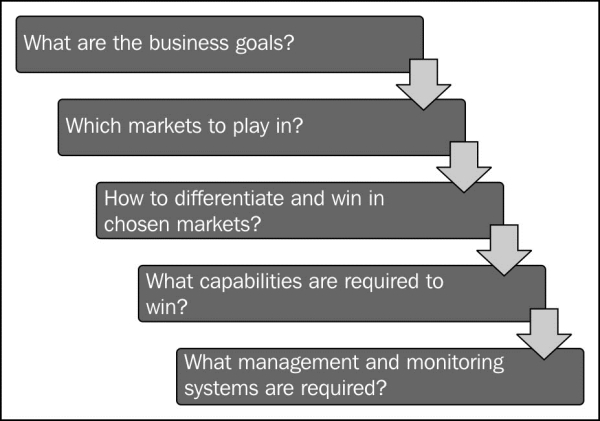After you have developed your strategy and harmonized all existing initiatives around it, now you need to communicate the strategy to the rest of the organization. You want the various teams in your business to align with that strategy and build their plans, goals, and execution capabilities around it. This process is called strategic cascade. It is about more than simple communication. A strategy cascade involves breaking down the strategy into context relevant for the various teams and developing their business plan and monitoring mechanisms around it.
A good strategic cascade will go into some detail and should be done for each of the individual initiatives that are triggered by the various strategies. To effectively cascade your big data strategies, you need to compose, clarify, and communicate your strategy framework to the entire organization in the context of data and its implications. Big data is pervasive and the strategy you develop and implement will have a bearing on everybody in the company. Big data is also for everybody; whether your company is big or small, you could equally benefit from big data. You need to translate the different facets of your big data strategy and the resulting initiatives into something that the entire organization will understand. Big data is an evolving discipline. The more people you can get on board your big data journey, the more hands you have to exploit the new emerging capabilities. You will also have a bigger pool of people who can see new value in data and create new value from data. Lofty and vague explanations can be confusing and interpreted differently. While designing your cascade plans, it is crucial to specify micro level details so that people understand clearly and nothing is left to speculation.
A normal strategic cascade follows a systematic process. The following diagram is a representation used when developing the cascade, and many organizations use formats similar to this:

Let's consider an example of how to develop a strategy cascade. Imagine you are a manufacturer of capital intensive equipment that is used by generic hospital and schools—say X-ray machines. In most cases, you have maintenance contracts with your customers. As part of these contracts, you are responsible for the general upkeep of your equipment and provide replacement parts at discounted rates. After careful and detailed studies, you have arrived at the conclusion that using Big Data Analytics, you can significantly grow your service business, which gives you good profits and also helps you secure repeat business. Let's now develop a strategy cascade using the methodology outlined in the preceding figure:
What are the business goals?
Increase service revenue by 30 percent in 3 years
Which markets can we play in?
K-12 schools market in tier-1 and tier-2 cities
The reason for selecting this market is that in such locations, customers have limited choices and they are difficult for your traditional competitors to cover. In each school, you may only have 1 machine. However, when you add up all the schools in a state you are now talking very big numbers. Such machines are also sold to hospitals at a good profit margin. However, as part of your strategy you choose to ignore the more seemingly profitable hospital segment for this initiative because you have found they have more internal capabilities to service your equipment and are less reliant on you other than for parts.
How to differentiate between and win in the chosen markets?
Provide predictive analytics on how to increase the equipment life and reduce operating costs, and offer other advisory services around student health by enabling a larger community of health experts from around the nation.
The reason you choose this differentiation approach is that your small time local entrepreneurs who can provide regular routine inspection and maintenance services will find it difficult to extend their offering portfolio.
What capabilities are required to win?
Remotely connecting to equipment very inexpensively
Store and analyze the performance data that comes from those X-ray machines (not the X-rays themselves as privacy issues may be involved)
Service team or channel that can respond to the needs of customers
A team of statisticians, engineers, and other experts who can continuously keep doing more experimental analysis
A team of expert doctors who can be made available using technology to help your schools
What management and monitoring systems are required?
New business models, operating disciplines, and monitoring and review mechanisms to ensure business goals are met
Many of these steps may seem similar to traditional IT initiatives; however, when we take into account the huge volumes and variety of data, and consider both structured and unstructured data, this initiative becomes a big data problem.
The simplified strategy cascade for the preceding situation can be represented in the following manner.

The above format is a tool that you can use to communicate and cascade your strategy to the rest of the business. If you choose a different format, make sure it is visual and easy to follow. Once you have developed your strategy cascade, it is clear to your team and the rest of the organization which markets are you vying for, how you plan to differentiate your business to win more in those markets, what kind of tools and capabilities you need to differentiate and win, and how you are going to monitor and manage the initiatives around growth. Your team and the rest of the business are now aligned with your plans and all geared up to go and win.

